
East Grinstead High Level Station: Gallery 6:
1966 - 1968 
Facing west with what is thought to be the LCGB 'The Reunion Rail Tour' of 10 December 1966 in the background. Assuming this to be the case, the locomotive was BR Standard Class 4 4-6-0 No. 75075. She had arrived at East Grinstead via Oxted and ran round her train before continuing to Three Bridges, which will be why she is seen approaching Platform 3. Obviously it was necessary to run round the eight-car train outside the confines of the station. Of the two bowstring structures between the tracks, the nearest is part of the bridge carrying the station over its subway and the furthest is part of Station Road bridge.
Photo by Alan & Lynne Cullen 
A further view of No. 75075 with 'The Reunion Rail Tour' of 10 December 1966. Unfortunately we cannot be certain what, if anything, is coupled behind the tender although the patch of daylight beneath the rear of the tender suggests nothing. If so the locomotive is in the process of running round the train and the drift of the steam would suggest she was running tender-first. The locomotive's double chimney is here obscured by steam.
Photo by Alan & Lynne Cullen  Another view assumed to be another taken on the occasion of 'The Reunion Rail Tour', Platform 5 is creaking under the weight of enthusiasts and considering this was December it is interesting to note the variations in clothing. Most of the time, of course, the enthusiasts would be onboard the warm steam-heated train. While some raincoats can be seen, by this time the raincoat, a garment which became synonymous with a certain generation of enthusiasts and sparked a degree of ridicule was starting to go out of vogue. The anorak and duffle coat were the successors and examples of both can be espied here.
Photo by Alan & Lynne Cullen 
No. 75075 has now completed her run round and is ready to depart from Platform 3 for Three Bridges. At the latter station she would be detached and replaced by Bulleid Pacific No. 34089 '602 Squadron' for the next stage of the tour to Brighton.
Photo by Alan & Lynne Cullen 
On an unknown date in the 1960s BRC&W Co. Type 3 diesel-electric No. D6566 has the 'Right Away' for departure to, presumably, Tunbridge Wells West. Having departed eastbound, some of these ex-London trains called at all stations while others called only at Forest Row and Groombridge but we have no way of knowing where this particular train would call. The BRC&W Co. Type 3 is a very versatile machine of 1,550HP on a Bo-Bo wheel arrangement. They have driving controls duplicated each side of each cab and many were later fitted for Push-Pull working, predominantly with the 'TC' trailer sets. Withdrawn as No. 33048 in February 1997, she is one of several class members to have survived into preservation.
Photo by Alan & Lynne Cullen 
The view from the east end of Platforms 4/5 towards Forest Row in the 1960s. London Road bridge is in the background; two track passed beneath it, on the left the single track running line and on the right a siding which ended just beyond the bridge. The sidings on the right are at a slightly higher level, possibly a legacy of the original terminus being replaced by the through line. East signal box, seen here, was the largest of the four 'boxes controlling East Grinstead but in 1958 it had been redesignated 'B Box'. Both A (the former West 'box) and B boxes survived in use until the line closed.
Photo by Alan & Lynne Cullen 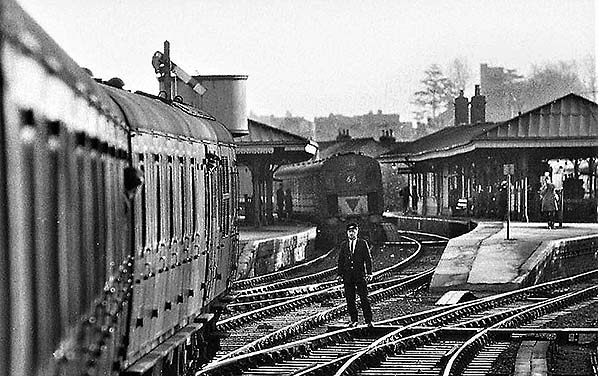 On what is assumed to be the final day of service a DEMU arrives at Platform 4 from Three Bridges, its guard about to hand the train staff to the signalman. The unit at Platform 5, displaying headcode 66, will depart for Victoria via Oxted.
Photo
from Jim Lake collection
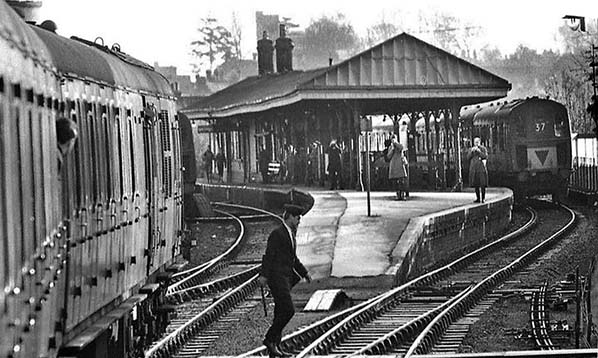
Another view of what is assumed to be the final day of service, with at least four DEMUs present as are a number of what are quite obviously railway enthusiasts. The unit at near left is arriving at Platform 4 from Three Bridges, its guard having just handed the train staff to the signalman of 'A' Box. He will return to his 'box, reset points and signals as required and then hand the staff to the driver or guard of the unit on the right which will depart for Three Bridges. The headcode '37' applied at this time to Tunbridge Wells West - Three Bridges and vice versa. Until 1963 it had also applied to Horsted Keynes - Haywards Heath - Seaford and after 1963 to Haywards Heath - Seaford. The code was also used for London Bridge - Reigate via Redhill, thus one code was used for several routes providing none shared the same tracks at any point en route. The same multi-use system applied to Southern disc/lamp headcodes.
Photo from Jim Lake collection 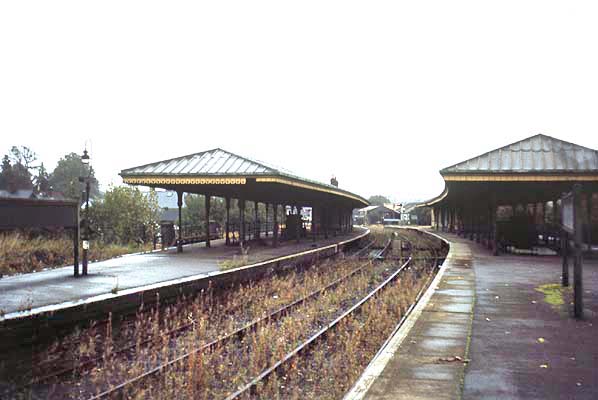
East Grinstead station looking east from platform 4 in November 1967, ten months after closure. The track bed is becoming overgrown with weeds. The top of the subway can be made out below the canopy.
Photo by Nick Catford 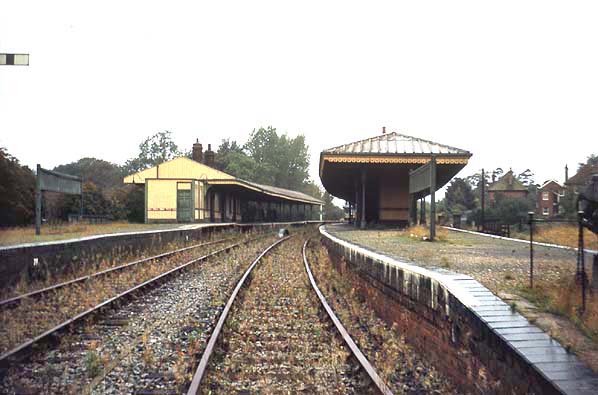
East Grinstead station looking west from the overgrown track bed in November 1967. Platforms are from left to right 3, 4, 5 and 6. Photo by Nick Catford 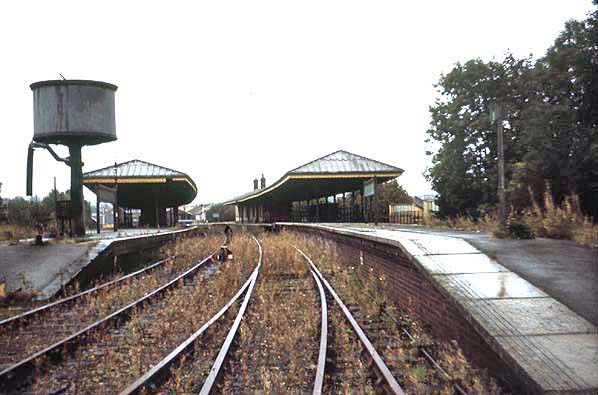 East Grinstead station looking east in November 1967. Ten months after closure apart from the removal of signs, little has changed. The top of the steps down to the entrance building and low level platforms 1 and 2 is seen on the right.
Photo
by Nick Catford

Sometime after closure a Class 33 diesel locomotive sits at Platform 3 with the Low Level footbridge visible to her left. She was likely involved with track lifting or some other form of material recovery operations. The period is most likely late 1967 - early 1968 as track remains through Platform 3 and that platform's building. Even a gas light survives intact; these were often among the first items to either vanish or be vandalised. By 1969 the final track through High Level was that through Platform 6, this being lifted later that year along with St Margaret's Curve and the line towards Three Bridges.
Photo by Chris Majer  Wagons of the demolition train seen here in the station during 1968, with gas cylinders on the platform to the left. These trains were usually worked by Class 33 diesel locomotives, perhaps unsurprisingly given this was the Southern Region. The Ashurst Junction (Groombridge) to East Grinstead, including through the High Level platforms, section was dealt with first. The track onwards towards Grange Road and also St Margaret's Curve were left in situ a little longer with lifting of these beginning in the Autumn of 1969 and completed by the end of that year. The removal of the High Level platforms allowed Station Road bridge with its restricted, 13ft, headroom to be dealt with. This photograph offers a quite rare close-up view of one the subway entrances. The railed-in area beyond was where the High Level platforms crossed those at the Low Level. Wagons of the demolition train seen here in the station during 1968, with gas cylinders on the platform to the left. These trains were usually worked by Class 33 diesel locomotives, perhaps unsurprisingly given this was the Southern Region. The Ashurst Junction (Groombridge) to East Grinstead, including through the High Level platforms, section was dealt with first. The track onwards towards Grange Road and also St Margaret's Curve were left in situ a little longer with lifting of these beginning in the Autumn of 1969 and completed by the end of that year. The removal of the High Level platforms allowed Station Road bridge with its restricted, 13ft, headroom to be dealt with. This photograph offers a quite rare close-up view of one the subway entrances. The railed-in area beyond was where the High Level platforms crossed those at the Low Level.Photo from Jim Lake collection Click here for East Grinstead High Level: Gallery 7
1968 - 2005
|


 Home Page
Home Page